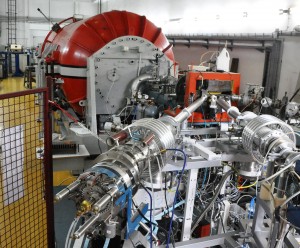Laboratory for ion beam interactions has long and fruitful experience in organization of international research meetings connected to development and applications of ion beam analysis and ion beam modification techniques as well as related developments of accelerator and detector technology. Since the formation of national center of excellence CEMS, research unit Ion beam physics and technology has organized, or plans organization of many international research meetings.
Category Archives: Ion Beam Physics and Technology
Priopcenje za javnost povodom opstruiranja financiranja iz EU fondova od strane MZOS-a
PRIOPĆENJE ZA JAVNOST – Zagreb, 7. lipnja 2016.
Otvoreno pismo ministru znanosti, obrazovanja i sporta Predragu Šustaru:
‘‘Opstruiranjem financiranja iz EU fondova hrvatskih znanstvenih centara izvrsnosti ugrožava se 50 milijuna eura iz strukturnih fondova i radna mjesta za hrvatske znanstvenike – traži se hitna reakcija ministra Šustara!‘‘
Pedeset milijuna eura, upitna radna mjesta za čak tri stotine doktoranada i postdoktoranada, te riskiranje penala od Europske komisije, samo su dio crne statistike koja ozbiljno prijeti Republici Hrvatskoj (RH), a odvija se u sjeni problema s kurikularnom reformom.
Deset znanstvenih centara izvrsnosti proglašenih od strane Ministarstva znanosti obrazovanje i sporta (MZOS) tijekom 2014. i 2015. godine na prijedlog Nacionalnog vijeća za znanost, visoko obrazovanje i tehnološki razvoj, posljednjih su nekoliko mjeseci postalo taocem MZOS-a.
Naime, RH se strateški odredila kroz Operativni program (OP) za financiranje Znanstvenih centara izvrsnosti (2014 – 2020), te se prema Operativnom programu očekuje 50 milijuna eura iz Europskog fonda za regionalni razvoj (ERDF) koji bi bili na raspolaganju proglašenim centrima.
Kako bi centri mogli iskoristiti europska sredstva, MZOS je obvezan raspisati natječaj. Prvi indikativni rok za raspisivanje natječaja bio je 31. ožujka, te je pomaknut na 1. lipnja 2016., a natječaj još nije raspisan.
Unatoč brojnim službenim molbama za poštivanjem obveza koje su voditelji Znanstvenih centara izvrsnosti posljednjih mjeseci dostavili ministru Šustaru i premijeru Oreškoviću s upozorenjem da je RH preuzela obvezu te je dužna raspisati planirani natječaj iz strukturnih fondova u sklopu kojih bi se izvršila evaluacija planiranih troškova u okviru pojedinih centara, s današnjim datumom MZOS još uvijek nije aktivirao natječaj Europskog fonda za regionalni razvoj (ERDF) koji bi omogućio povlačenje čak 50 milijuna eura za Znanstvene centre izvrsnosti. Time se ozbiljno ugrožava realizacija znanstvenih aktivnosti proglašenih ZCI-a i gubitak 50 milijuna eura iz EU te zapošljavanje 300 mladih stručnjaka.
Podsjetimo, MZOS je proglasio Znanstvene centre izvrsnosti iz područja prirodnih, biomedicinskih, biotehničkih i tehničkih znanosti nakon zahtjevnih kriterija javnog natječaja, uključujući opsežne domaće i međunarodne recenzije i intervjue s voditeljima predloženih centara koji su proveli Agencija za znanost i visoko obrazovanje (AZVO) i Nacionalno vijeće za znanost, visoko obrazovanje i tehnološki razvoj. MZOS je potom temeljem članka 29. stavka 2. Zakona o znanstvenoj djelatnosti i visokom obrazovanju (Narodne novine, broj: 123/2003, 105/2004, 174/2004, 2/2007 – Odluka Ustavnog suda Republike Hrvatske, 46/2007, 45/2009,63/2011,94/2013, 139/13 i 101/2014 – Odluka i Rješenje Ustavnog suda Republike Hrvatske) proglasilo znanstvene centre izvrsnosti RH, čiji su članovi izvrsni hrvatski znanstvenici, među nositeljima međunarodne prepoznatljivosti hrvatske znanosti.
Proces prijave, vrednovanja i odabira centara trajao je tri godine, a Vlada RH je nakon provedenog postupka recenzija uskladila program centara s nacionalnim prioritetima i oni su u skladu sa Strategijom pametne specijalizacije (S3). Ovu Strategiju su više od dvije godine izrađivali brojni eksperti iz javnog i privatnog sektora koji se bave istraživanjem i razvojem, te ju je usvojio Hrvatski sabor i Europska komisija za znanost.
Cilj proglašenja centara je bio omogućiti izvrsnim hrvatskim znanstvenicima i institucijama uvjete za vrhunski istraživački rad kroz stabilno i pojačano financiranje te edukaciju mladih znanstvenika i značajan doprinos gospodarstvu RH.
Slijedom navedenog, proizlazi da se nepoštivanjem zadanih obveza od strane MZOS-a te neprovođenjem preuzetih obveza direktno ugrožavaju nacionalni interesi.
Nažalost, jedan od glavnih protivnika ustroja hrvatskih centara izvrsnosti, kao i od strane Europske komisije usvojene pametne specijalizacije (S3) RH, a koja je jedan od glavnih preduvjeta za povlačenje sredstava iz strukturnih fondova, je pomoćnik ministra za znanost dr. sc. Krešimir Zadro.
Poštovani ministre Šustar, otvorenim pismom javnosti obraćamo Vam se ispred svih Znanstvenih centara izvrsnosti (ZCI) iz područja prirodnih, biomedicinskih, biotehničkih i tehničkih znanosti sa zahtjevom da se javno očitujete o razlozima nepoštivanja odluka Vlade RH i neprovođenju usvojenih programa financiranja hrvatskih centara izvrsnosti iz EU fondova te datumu raspisivanja natječaja kako bi se izbjegao crni scenarij.
Vjerujemo da niste spremni potpuno ignorirati izvrsne hrvatske znanstvene skupine i propustiti priliku da se kroz usvojeni program pametne specijalizacije povuku sredstva u iznosu od 50 milijuna eura iz strukturnih fondova.
U situaciji kad se domaća sredstva za znanost i istraživanje sustavno režu, kad se događa egzodus najboljih mladih obrazovanih stručnjaka, znanstvena istraživanja i inovacije preživljavaju velikim dijelom zbog izvrsnosti istraživačkih skupina i velikih napora znanstvenika u povlačenju sredstva iz programa Europske unije, ovakvo opstruiranje rada Znanstvenih centara izvrsnosti da osiguraju europska sredstva za rad i zapošljavanje stručnog kadra je nedopustivo!
S poštovanjem,
voditelji proglašenih Znanstvenih centara izvrsnosti (STEM područja):
Znanstveni centar izvrsnosti za napredne materijale i senzore,
Institut Ruđer Bošković i Institut za fiziku, Zagreb
Dr. sc. Milko Jakšić – Milko.Jaksic@irb.hr
Dr. sc. Mile Ivanda – Mile.Ivanda@irb.hr
Dr. sc. Mario Stipčević – Mario.Stipcevic@irb.hr
Dr. sc. Marko Kralj – mkralj@ifs.hr
Znanstveni centar izvrsnosti za reproduktivnu i regenerativnu medicinu,
Medicinski fakultet, Sveučilište u Zagrebu,
Akademik prof. dr.sc. Slobodan Vukičević – slobodan.vukicevic@mef.hr
Prof. dr. sc. Davor Ježek – davor.jezek@mef.hr
Znanstveni centar izvrsnosti za virusnu imunologiju i cjepiva,
Medicinski fakultet, Sveučilište u Rijeci
Prof. dr. sc. Stipan Jonjić – stipan.jonjic@medri.uniri.hr
Znanstveni centar izvrsnosti za znanost i tehnologiju – STIM, Sveučilište u Splitu
Prof. dr. dr. h.c. Vlasta Bonačić-Koutecky – vbk@cms.hu-berlin.de
Znanstveni centar izvrsnosti za bioraznolikost i molekularno oplemenjivanje bilja, Agronomski fakultet , Sveučilište u Zagrebu
Prof. dr. sc. Zlatko Šatović – zsatovic@agr.hr
Institut Ruđer Bošković, Zagreb
Dr.sc. Rozelindra Čož-Rakovac – Rozelindra.Coz-Rakovac@irb.hr
Znanstveni centar izvrsnosti za kvantne i kompleksne sustave te reprezentacije Liejevih algebri, Prirodoslovno-matematički fakultet, Sveučilište u Zagrebu
Prof.dr.sc Hrvoje Buljan – hbuljan@phy.hr
Prof. dr. sc. Pavle Pandžić – pandzic@math.hr
Znanstveni centar izvrsnosti za personaliziranu brigu o zdravlju,
Sveučilište Josip Juraj Strossmayer u Osijeku
Prof. dr. sc. Gordan Lauc – glauc@pharma.hr
Prof. dr. sc. Ines Drenjančević – ines.drenjancevic.peric@mefos.hr
Znanstveni centar izvrsnosti za temeljnu, kliničku i translacijsku neuroznanost, Medicinski fakultet, Sveučilište u Zagrebu
Prof. dr. sc. Miloš Judaš – mjudas@hiim.hr
Znanstveni centar izvrsnosti za znanost o podatcima i kooperativne sustave, Fakultet elektrotehnike i računarstva, Sveučilište u Zagrebu
Prof.dr.sc. Sven Lončarić – sven.loncaric@fer.hr
Prof. dr. sc. Ivan Petrović – ivan.petrovic@fer.hr
Priopćenje voditelja proglašenih
Znanstvenih centara izvrsnosti (STEM područja) ___________________________________________________________________________________________________
Development of the MeV SIMS with sub micron resolution
The MeV secondary ion mass spectrometry (SIMS) technique is based on a concept being developed already in 1974, when the first publications about the desorption of molecular ions using fission fragments from 252Cf source (plasma desorption mass spectrometry – PDMS) appeared. In 2008, group of prof. J. Matsuo from Kyoto University started to use MeV ions from ion beam accelerator accompanied by a time of flight (TOF) mass spectrometer. Comparison to the keV energy ions (used in conventional SIMS), showed significant suppression of fragmentation and simultaneously enhancement the secondary ion yield, which is in particular evident for higher mass molecules (100-1000 Da).
In 2012, Time of Flight Secondary Ion Mass Spectrometry (ToF-SIMS) setup was constructed and installed at the RBI microbeam beam line as a result of bilateral Croatian – Japan project “Enhanced molecular imaging by focused swift heavy ions”. In attempt to make this technique widely accepted, RBI group performed numerous tests of its applicability to biomedical problems, cultural heritage studies and materials science. Presentely, this work is supported by three international projects on MeV SIMS: ITN Marie Curie SPRITE project on MeV SIMS, UKF project “Study of modern paint materials and their stability using MeV SIMS and other analytical techniques“ and IAEA CRP project “Development of molecular concentration mapping techniques using MeV focused ion beams”.
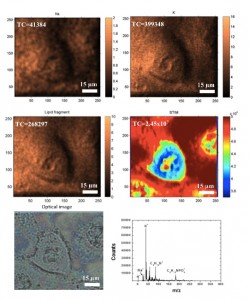
2D distribution of Na, K, and lipids in CaCo-2 cell. A STIM image (density distribution) is also presented, together with an optical image and TOF-SIMS spectrum.
In the case of biomedical applications it is important to perform molecular mapping at the subcellular level. However, the beam spot size of the existing MeV TOF-SIMS systems, which is typically several microns, is too large and has to be reduced. In order to improve the lateral resolution of the focussed beam, the trigger for the TOF – START was replaced with a timing signal provided by a silicon charged particle detector used for Scanning Transmission Ion Microscopy (STIM). By using a trigger signal from detector instead of the bunching the ion microbeam, significant reduction of the object and collimator slit openings was enabled, leading to the reduction of the ion beam spot size (down to 300 nm). Altogether, due to the well-defined submicron beam focus and the high sensitivity, molecular imaging of a single cell at a sub-cellular level has been for the first time achieved by MeV TOF-SIMS as well. Results of this work has been recently published in Applied Physics Letters: Z. Siketić, I. Bogdanović Radović, M. Jakšić, M. Popović Hadžija, M. Hadžija, Submicron mass spectrometry imaging of single cells by combined use of mega electron volt time-of-flight secondary ion mass spectrometry and scanning transmission ion microscopy. In addition, the leading author of the APL paper Zdravko Siketić, presented this work by invited talk at the 13th International Symposium on Radiation Physics held in September in Beijing, China.
Response of the graphene and gallium nitride to swift heavy ion irradiation
Irradiation of flat solid surface by swift heavy ions can result in the formation of nanoscale surface features like hillocks or craters. These remnants of ion impacts called ion tracks can be observed directly using atomic force microscopy (AFM). Within the research unit Ion Beam Physics and Technology, we have demonstrated in two recently published papers that swift heavy ion beams are versatile tool for nanostructuring graphene and GaN.
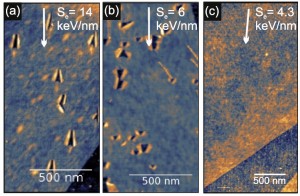
Monolayer graphene after exposure to grazing incidence swift heavy ion irradiation (a) 84 MeV Ta, (b) 23 MeV I, (c) 15 MeV Si
In the work “Nanostructuring graphene by dense electronic excitation”, published in Nanotechnology (journal IF = 3.821) we reported detailed investigation of graphene response to the swift heavy ion irradiation in a wide range of energies. It was demonstrated that medium scale accelerator facilities like the one at the RBI can be used successfully for nanostructuring graphene (Figure 1.). By choosing appropriate ion beam irradiation parameters, not only graphene can be pierced, thus producing nanoscale pores within it, but also different kind of defects can be introduced into it in a controlled manner. The study was done in a collaboration with scientists from Germany (Universities Duisburg-Essen, Ulm and Jena), France (GANIL ion accelerator facility in Caen) and RBI (M. Karlušić, M. Jakšić).
In the work “Response of the GaN to energetic ion irradiation: conditions for ion track formation” published in J. Phys. D: Appl. Phys. (journal IF = 2.721) and featured on the journal cover page, we reported results of our investigations regarding swift heavy ion irradiation of wurzite GaN surface, and showed for the first time that grazing incidence small angle X-ray scattering (GISAXS) can be utilized for analysis of such irradiated surface (Figure 2.).

Irradiated GaN surface at IRRSUD, GANIL with 92 MeV Xe, Θ = 1°, Φ = 100/μm2 (a) AFM image and GISAXS spectra taken at different azimuthal angles with respect to orientation of the surface ion tracks: 0° (b), 2° (c), 10° (d).
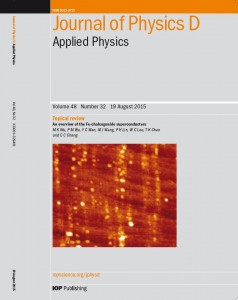 In contrast to previous works where nanohillocks were found within the surface ion track, morphology of 92 MeV Xe ion tracks consist of both nanohillocks and nanoholes. For lower energy irradiation using 23 MeV I, ion tracks consist only of nanoholes. In addition, TOF-ERDA measurements showed significant loss of nitrogen during irradiation and opens up the question of the composition of ion tracks. The study was done by the team of scientists from the RBI ion accelerator facility (M. Karlušić, M. Buljan, Z. Siketić, M. Jakšić, B. Šantić), in collaboration with colleagues from GANIL ion accelerator facility (Caen, France), HZDR (Dresden, Germany), Elettra synchrotron (Trieste, Italy) and Universities Duisburg-Essen and Ulm (Germany).
In contrast to previous works where nanohillocks were found within the surface ion track, morphology of 92 MeV Xe ion tracks consist of both nanohillocks and nanoholes. For lower energy irradiation using 23 MeV I, ion tracks consist only of nanoholes. In addition, TOF-ERDA measurements showed significant loss of nitrogen during irradiation and opens up the question of the composition of ion tracks. The study was done by the team of scientists from the RBI ion accelerator facility (M. Karlušić, M. Buljan, Z. Siketić, M. Jakšić, B. Šantić), in collaboration with colleagues from GANIL ion accelerator facility (Caen, France), HZDR (Dresden, Germany), Elettra synchrotron (Trieste, Italy) and Universities Duisburg-Essen and Ulm (Germany).
Projects
HRZZ: Ion Beam Induced Changes in Crystaline Materials (MIOBICC), 2014-2018, Principal investigator, Stjepko Fazinić
HRZZ: Nuclear structure and reactions – experiments towards the neutron drip line, 2014-2018, Principal investigator, Suzana Szilner
HRZZ: Nano-networks of Quantum Dots in Glasses: From Self-assembly to Energy Conversion and Hydrogen Storage, 2014-2018, Principal investigator, Maja Buljan
EU H2020 project EuroFusion, 2014-2018, Project coordinator for RBI, Tonči Tadić
EU H2020 project AIDA – Advanced European Infrastructures for Detectors at Accelerators, 2015-2019, Project coordinator for RBI, Stjepko Fazinić
EU H2020 ERA Chair project PARADESEC – Expanding Potential in Particle and Radiation Detectors, Sensors and Electronics in Croatia, 2015-2020, Project coordinator, Neven Soić
NATO SPS project E-SiCure – Engineering silicon carbide for enhanced borders and ports security, 2016-2020, Voditelj project, Ivana Capan
IAEA CRP F11020: Development of single ion irradiation techniques and probing the induced changes in SiC and diamond , 2017-2020, Principal investigator, Milko Jakšić
IAEA CRP F11019: Development of molecular concentration mapping techniques using MeV focused ion beams, 2014-2018, Principal investigator, Zdravko Siketić
COMPLETED PROJECTS:
EU FP7 project SPRITE – Supporting Postgraduate Research with Internship in industry and Training Excellence – Marie Curie Initial Training Network, 2013-2016, Project coordinator for RBI, Milko Jakšić
UKF: Study of modern paint materials and their stability using MeV SIMS and other analytical techniques (2012-2015), Principal investigator, Ivančica Bogdanović Radović
IAEA CRP CRO-17051: Radiation hardness of semiconductors and insulators studied by focused ion beam irradiation and IBIC, 2012-2105, Principal investigator, Milko Jakšić
IAEA CRP CRO-18227: Environmental protection and monitoring of cultural heritage objects and applied research on structured materials for photo-electric energy conversion, 2014-2017, Principal investigator, Stjepko Fazinić
Bilateral project with Germany (MZOS-DAAD), Technische Universitatet Berlin, Micro X-ray Emission Spectroscopy (MIXES), 2015-2016, Principal investigator, Stjepko Fazinić
Bilateral project with Slovenia, Molecular imaging of biological samples using MeV ions and keV clusters for TOF-SIMS spectrometry, Principal investigator, Zdravko Siketić
Talks and Publications
Complete (and updated) list of published articles is available HERE.
Invited conference talks:
• Diamond membrane detectors, Milko Jakšić, 9th International Conference on New Diamond and Nano Carbons (NDNC-2015), Shizuoka, Japan (May 24 – 28, 2015)
• Formation and tailoring of metal and semiconductor quantum dots in amorphous matrices by MeV ions, Iva Bogdanović Radović, 22nd International Conference on Ion Surface Interaction, Moscow, Russia (August 20 – 24, 2015)
• MeV-SIMS spectrometry – novel heavy ion microbeam technique for cultural heritage studies and molecular imaging of thin samples with sub-micrometer spatial resolution, Zdravko Siketić, 13th International Symposium on Radiation Physics (ISRP-13), Beijing, China (September 7 – 11, 2015)
• Masena spektrometrija sekundarnih molekularnih iona pomoću iona MeVskih energija (MeV SIMS) – nova metoda za karakterizaciju modernih slikarskih materijala, Iva Bogdanović Radović, 9. Znanstveni sastanak hrvatskog fizikalnog društva, Umag, Hrvatska (5.-7.10.2015.)
• Capabilities of the RBI accelerator facility for the ion microbeam probing of charge collection properties in radiation detectors, Milko Jakšić, 11th International Workshop on Radiation Effects on Semiconductor Devices for Space Applications, Kiryu, Japan (November 11 – 13, 2015)
• Irradiation Defects in Diamond – Studies of Single Crystal Diamond Membranes Using Ion Microbeam, Milko Jakšić, International Union of Materials Research Societies – International Conference on Electronic Materials (IUMRS-ICEM 2016), Singapore (July 4-8, 2016)
• Single ion microprobe techniques, current status and perspectives, Milko Jakšić, 15th International Conference on Nuclear Microprobe Technology and Applications (ICNMTA), Lanzhou, China (July 31 – August 5, 2016)
• Molecular imaging of biological and cultural heritage samples using MeV-SIMS, Zdravko Siketić, 24th Conference on Application of Accelerators in Research and Industry (CAARI), Fort Worth, Texas, USA (30th Oct. – 4th Nov., 2016.)
• Two modes for molecular imaging using MeV SIMS at the heavy ion microprobe, Zdravko Siketić, 12th European Conference on Accelerators in Applied Research and Technology (ECAART12), Jyvaskyla, Finland (4 Jul 2016)
• TOF-ERDA Spectrometry promoted by 1 keV Ar sputtering, Zdravko Siketić, 23rd International Conference on Ion Beam Analysis (IBA), Shanghai, China (Oct. 8-13, 2017.)
• Lipidomic analysis of the healthy and diabetic mouse liver and serum using MeV-SIMS, Zdravko Siketić, 21st International Conference on Secondary Ion Mass Spectrometry (SIMS21), Krakow, Poland (September 10-15, 2017.)
• Chemical imaging of the healthy and diabetic mouse liver using MeV TOF-SIMS, Zdravko Siketić, 16th International Conference on Nuclear Microprobe Technology and Applications (ICNMTA2018), Guildford, UK (July 8-13, 2018.)
• Laboratory for Ion Beam Interactions-Research, Development & Applications, Zdravko Siketić, 2nd ENSAF Workshop, Athens, Greece (October 3-5, 2018.)
• Extreme Radiation Hardness and Signal Recovery in Thin Diamond Detectors, Natko Skukan, 16th International Conference on Nuclear Microprobe Technology and Applications (ICNMTA2018), Guildford, UK (July 8-13, 2018.)
Selected publications:
• Submicron mass spectrometry imaging of single cells by combined use of mega electron volt time-of-flight secondary ion mass spectrometry and scanning transmission ion microscopy, Z. Siketić, I. Bogdanović Radović, M. Jakšić, M. Popović Hadžija, and M. Hadžija, Applied Physics Letters 107 (2015) 093702
• Electroluminescence from nitrogen-vacancy and interstitial-related centers in bulk diamond stimulated by ion-beam-fabricated sub-superficial graphitic micro-electrodes, J. Forneris, S. Ditalia Tchernij, A. Battiato, F. Picollo, A. Tengattini, V. Grilj, N. Skukan, G. Amato, L. Boarino, I. P. Degiovanni, E. Enrico, P.Traina, M. Jakšić, M. Genovese, P. Olivero, accepted in Scientific Reports (2015)
• Response of GaN to energetic ion irradiation: conditions for ion track formation, M. Karlušić, R. Kozubek, H. Lebius, B. Ban-d’Etat, R. A. Wilhelm, M. Buljan, Z. Siketić, F. Scholz, T. Meisch, M. Jakšić, S. Bernstorff, M. Schleberger and B. Šantić, J. Phys. D: Appl. Phys. 48 (2015) 325304
• Measurements of proton induced γ-ray emission cross sections on MgF2 target in the energy range 1.95-3.05 MeV, I. Zamboni, Z. Siketić, M. Jakšić, I. Bogdanović Radović, Nucl. Instr. and Meth. B342 (2015) 266–270
• Ion beam induced luminescence (IBIL) system for imaging of radiation-induced changes in materials, N. Marković, Z. Siketić, D. Cosić, H.K. Jung, N.H. Lee, W.T. Han, M. Jakšić, Nucl. Instr. and Meth. B343 (2015) 167-172.
• Proton-radiation resistance of poly(ethylene terephthalate) – nanodiamond – graphene nanoplatelet nanocomposites, V. Borjanović, L. Bistričić, I. Pucić, L. Mikac, R. Slunjski, M. Jakšić, G. McGuire, A. Tomas Stanković, O. Shenderova, J. Mat. Sci. (2015)
• Nanostructuring graphene by dense electronic excitation, O. Ochedowski, O. Lehtinen, U. Kaiser, A. Turchanin, B. Ban-d´Etat, H. Lebius, M. Karlusic, M. Jaksic, M. Schleberger, Nanotechnology 26 (2015) 465302
• Spectroscopic properties and radiation damage investigation of a diamond based Shottky diode for ion-beam therapy microdosimetry, Claudio Verona, Giulio Magrin, Paola Solevi, Veljko Grilj, Milko Jaksic, Ramona Mayer, Marco Marinelli, and Gianluca Verona Rinati, accepted in J. Appl. Phys. (2015).
• Ion beam analysis of Cu(In,Ga)Se2 thin film solar cells, A.G. Karydas, C. Streeck, I. Bogdanovic Radovic, C. Kaufmann, T. Rissom, B. Beckhoff, M. Jaksic, N.P. Barradas, Applied Surface Science, 356 (2015) 631-638
• Charge multiplication effect in thin diamond films, N. Skukan, V. Grilj, I. Sudić, M. Pomorski, W. Kada, T. Makino, Y. Kambayashi, Y. Andoh, S. Onoda, S. Sato, T. Ohshima, T. Kamiya and M. Jakšić , Appl. Phys. Lett. 109, 043502 (2016)
• Formation of swift heavy ion tracks on a rutile TiO2 (001) surface, M. Karlušić, S. Bernstorff, Z. Siketić, B. Šantić, I. Bogdanović-Radović, M. Jakšić, M. Schleberger, M. Buljan, J. Appl. Cryst. (2016). 49, 1704-1712
• Single-Photon-Emitting Optical Centers in Diamond Fabricated upon Sn Implantation, S. Ditalia Tchernij, T. Herzig, J. Forneris, J. Küpper, S. Pezzagna, P. Traina, E. Moreva, I. P. Degiovanni, G. Brida, N. Skukan, M. Genovese, M. Jaksič, J. Meijer, P. Olivero, ACS Photonics, 2017, 4 (10)
• Creating nanoporous graphene with swift heavy ions, H. Vázquez, E.H. Åhlgren, O. Ochedowski, A.A. Leino, R. Mirzayev, R. Kozubek, H. Lebius, M. Karlušic, M. Jakšic, A.V. Krasheninnikov, J. Kotakoski, M. Schleberger, K. Nordlund, F. Djurabekova, Carbon 119 (2017) 200
Equipment
RBI accelerator facility consists of two accelerators, 1.0 and 6.0 MV electrostatic tandem accelerators (HVEC EN Tandem Van de Graaff and 1.0 MV HVE Tandetron) as well as 8 beam lines. One of the beam lines can accept simultaneously ion beams from both accelerators.
EN Tandem Van de Graaff accelerator has three ion sources, namely RF source with charge exchange for He ions, multi-cathode sputtering ion source for variety of ion species (H, Li, B, C, O, Si, Cl, Cu, Br, Au, etc.) and finally a home built sputtering source for rare beams including short lived radioactive beams.
Tandetron accelerator is equipped with direct extraction duoplasmatron source (for negative hydrogen ions) and sputtering ion source used for other ions (typically Li, C, O, Si, and heavier).
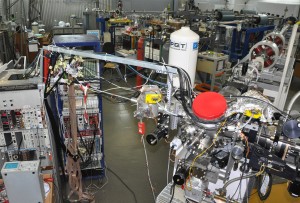
Presently, there are nine available end stations.
End stations that can accept ions from both accelerators are (from right to left):
– Nuclear microprobe facility
– Nuclear reactions scattering chamber
– High resolution PIXE spectrometer
– TOF ERDA
– IAEA beam line
– Irradiation and detector testing
– Dual beam irradiation and RBS channeling
End stations that can accept ions only from Tandetron accelerator are:
– In air PIXE
– PIXE/RBS end station
Facility is equipped with mechanical and electronic workshops, sample preparation equipment and several other sample characterization techniques.
Members
Division of experimental physics:
Laboratory for ion beam interactions
– Milko Jakšić, senior scientist, head of research unit
– Stjepko Fazinić, senior research associate
– Iva Bogdanović Radović, senior scientist
– Zdravko Siketić, research associate
– Tonči Tadić, senior research associate
Laboratory for nuclear physics
– Neven Soić, senior scientist
– Suzana Szilner, senior scientist
– Mile Zadro, senior scientist
Division of materials physics
– Maja Buljan, research associate
– Ivana Capan, senior research associate
– Marko Karlušić, research associate
University of Zagreb, Faculty of science, Department of physics
– Matko Milin, professor
Research topics
Scientific objectives of the proposal follow recommendation for research directions of the Nuclear Physics European Collaboration Committee (NUPECC), an Expert Committee of the European Science Foundation. More specifically, research objectives of the proposed Center of excellence include:
1) In research of ion beam interaction with matter, to explore processes related to ion impact to materials surface, which are still not well described (such as secondary electron emission and ion desorption), and which strongly depend on projectile type and energy. This is relevant for ion beam analysis techniques, which are sensitive to molecular composition. In the study of processes of charge collection in radiation detector materials, ion induced defects that degrade charge transport properties could also be beneficial and of technological importance as well.
2) In materials research, investigations will be focused on nanoscale changes in the materials followed upon the ion impact. Formation of surface nano-features and modifications of 2D materials (graphene) will be induced by single MeV heavy ions, while higher fluences will be required for investigations of processes that drive ion assisted assembly of nanostructured materials. Future research will clearly benefit from strong momentum those two recently opened research directions have.
3) In nuclear physics research to enlarge understanding of collective phenomena in nuclear structure (nucleon pairing and clustering) and reaction dynamics (multi-nucleon transfers at low energy), interaction between deformed and loosely bound nuclei, structure of neutron-rich nuclei and light nuclei reactions with significant effect on astrophysical phenomena. Important goal is enlarged contribution in development and testing of research infrastructure, including those for experiments at large international laboratories, which is closely related to objectives of other two research groups.
Ion Beam Physics and Technology
Ion beams of MeV energies are standard research tool in many areas of science, from basic nuclear physics to various topics in materials and medical studies. Besides the accelerators, experiments in these different physics fields share many other aspects, like many methods and techniques in both experimental work and data analysis. Here we start from these common features of experimental work and propose research plan for extensive studies in ion beam analysis, material physics, radiation detectors and low energy nuclear physics. Common instrumentation basis of the proposal is the accelerator complex of the Ruđer Bošković Institute which is the largest research facility in Croatia and the only one providing trans-national access to EU researchers within the FP7 program. State of the art techniques that already exist at the facility are excellent basis for the proposed research topics. . Another important ingredient for success of the proposed center is skilled, experienced and internationally recognized staff. Involved researchers have not only scientific expertise in these topics but also large experience in execution of internationally funded projects.
Interaction of ion beams with target matter is in the focus of all experimental approaches. Knowledge on the basic processes of ion interaction with matter will be used to characterize unknown target materials and in particular their composition. Novelty of this analytical approach is investigation of processes that are sensitive to chemical composition of the sample, such as desorption of surface molecules that could be analyzed by time-of-flight spectrometry. Considering controlled modification of the material, investigations of effects that ions have on the nanometer scale could be used to develop a novel nano-structuring tool. Recent discovery of quantum dots ordering using ion beams encourages this field of research. If an ion microbeam exposes radiation detectors, investigation of charge collection processes could be used to develop novel detector types. Here, investigations of diamond as a future sensor material offer numerous possibilities. Such developments will have, among others, strong impact to investigations of basic phenomena of nuclear physics, for which some particular accelerated ions collide with known target isotope with aim to investigate nuclear reactions. Using the RBI and other larger accelerator facilities, experiments will be proposed which target the key questions in understanding of nuclear collective phenomena (pairing, clustering), and nuclear astrophysics.
Finally, development of state of the art instrumentation, irradiation and analysis techniques, materials structuring tools and related technology, will ensure wider application of know-how in other research fields, in applications of public importance and in transfer of knowledge to industry, generating large impact on general society.

